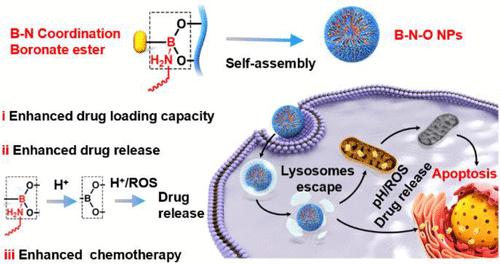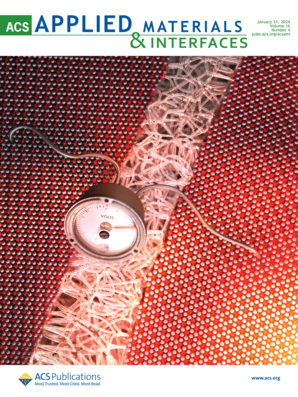A General “Two-Lock” Strategy to Enhance Drug Loading and Lysosomal Escape in Intelligent Boronate Ester Polymer Nanoparticles for Improved Chemotherapy
IF 8.3
2区 材料科学
Q1 MATERIALS SCIENCE, MULTIDISCIPLINARY
引用次数: 0
Abstract
Boronate ester can be used to prepare intelligent polymer nanoparticles (NPs). However, the traditional boronate ester polymer NPs made of boronic acid and diols using a “single-lock” strategy (B–O NPs) exhibit low drug loading capacity (DLC) and insufficient lysosomal escape ability, resulting in limited antitumor efficacy. We develop a “two-lock” strategy that combines dodecanamine and boronic acid using boron–nitrogen (B ← N) coordination to enhance the formation of a boronate ester polymer. Through this strategy, amphiphilic dextran and poly(vinyl alcohol) are synthesized through conjugation with the phenylboronic acid (PBA)/dodecanamine complex. The amphiphilic dextran encapsulates paclitaxel (PTX) to form B–N–O NPs with a higher DLC than their “single-lock” compartments due to enhanced boronate ester stability and improved hydrophobic drug-polymer interactions. Moreover, the B–N–O NPs release more PTX under acidic conditions compared with the B–O NPs. To demonstrate the generality of this “two-lock” strategy, eight polymer prodrug B–N–O NPs employing poly(vinyl alcohol) or dextran, along with PBA-modified gemcitabine, fluorouracil, and 7-ethyl-10-hydroxycamptothecin, or boronic acid-containing bortezomib and dodecanamine, are prepared, showing overall enhanced DLC and higher responsive drug release efficiency compared to B–O NPs. Importantly, B–N–O NPs with a combination of dodecanamine and boronic acid show a better lysosomal escape capability than B–O NPs. Moreover, B–N–O NPs exhibit stronger cytotoxicity compared to B–O NPs and free drugs in vitro. Their enhanced drug loading, responsive drug release, and lysosomal escape abilities contribute to enhanced antitumor efficacy in vivo. This “two-lock” strategy can be a general and convenient method to prepare responsive polymer NPs with enhanced anticancer efficacy.

一种通用的“双锁”策略来增强智能硼酸酯聚合物纳米颗粒的药物负载和溶酶体逃逸,以改善化疗
硼酸酯可用于制备智能聚合物纳米颗粒。然而,传统的由硼酸和二醇采用“单锁”策略制成的硼酸酯聚合物NPs (B-O NPs)具有较低的载药能力(DLC)和溶酶体逃逸能力不足,导致抗肿瘤效果有限。我们开发了一种“双锁”策略,利用硼-氮(B←N)配位将十二胺和硼酸结合起来,以促进硼酸酯聚合物的形成。通过这种策略,通过与苯硼酸(PBA)/十二胺配合物偶联合成了两亲性葡聚糖和聚乙烯醇。两亲性葡聚糖包封紫杉醇(PTX)形成的B-N-O NPs具有比其“单锁”隔室更高的DLC,这是由于增强的硼酸酯稳定性和改善的疏水药物-聚合物相互作用。此外,在酸性条件下,B-N-O NPs比B-O NPs释放更多的PTX。为了证明这种“双锁”策略的普遍性,我们制备了八种聚合物前药B-N-O NPs,采用聚乙烯醇或葡聚糖,以及经pba修饰的吉西他滨、氟尿嘧啶和7-乙基-10-羟基喜树碱,或含硼酸的硼替佐米和十二胺,与B-O NPs相比,DLC总体增强,药物释放效率更高。重要的是,含有十二胺和硼酸的B-N-O NPs比B-O NPs具有更好的溶酶体逃逸能力。此外,与B-O NPs和游离药物相比,B-N-O NPs在体外表现出更强的细胞毒性。它们增强的药物负荷,反应性药物释放和溶酶体逃逸能力有助于增强体内抗肿瘤功效。这种“双锁”策略可以作为一种通用且方便的方法来制备具有增强抗癌功效的反应性聚合物NPs。
本文章由计算机程序翻译,如有差异,请以英文原文为准。
求助全文
约1分钟内获得全文
求助全文
来源期刊

ACS Applied Materials & Interfaces
工程技术-材料科学:综合
CiteScore
16.00
自引率
6.30%
发文量
4978
审稿时长
1.8 months
期刊介绍:
ACS Applied Materials & Interfaces is a leading interdisciplinary journal that brings together chemists, engineers, physicists, and biologists to explore the development and utilization of newly-discovered materials and interfacial processes for specific applications. Our journal has experienced remarkable growth since its establishment in 2009, both in terms of the number of articles published and the impact of the research showcased. We are proud to foster a truly global community, with the majority of published articles originating from outside the United States, reflecting the rapid growth of applied research worldwide.
 求助内容:
求助内容: 应助结果提醒方式:
应助结果提醒方式:


